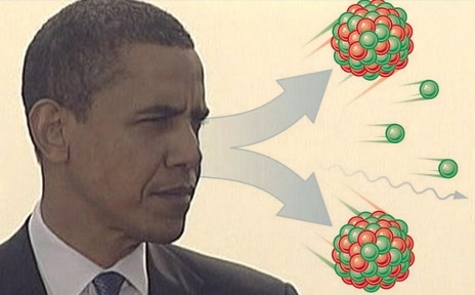Obama: The Nuclear President?


In his first State of the Union address, President Obama expressed his desire for America to build more nuclear power plants. But will divisive politics melt down any efforts to modernize and augment our country's aging nuclear infrastructure and spent fuel storage capability?
Nuclear energy adoption has for the last 30 years been a problem in the United States -- political wrangling and "Not in my back yard" arguments from both parties as well as the actions of special interest groups have essentially ground all new Nuclear Power research and infrastructure improvements to a halt.
Click on the "Read the rest of this entry" link below for more.
According to the US Department of Energy, no new nuclear power plant has been ordered or constructed since the 1970's and the last to be completed went on-line in 1996. The 104 existing US plants are operating at approximately 90 percent of capacity, generate only 12 percent of the United States's total generating capability, and only account for about 20 percent of our country's energy consumption.
Most of this country's nuclear reactors were ordered and built during the 1960s and 1970s. After this initial construction boom, It was once anticipated that more than 1000 reactors would be operating across the United States, but this was not to be. Almost 50 percent of the 253 reactors ordered since 1953 were canceled, 11 percent of the plants have been shut down, and 14 percent experienced at last a year or more outage. Only 27 percent have operated without a year-plus outage at all.
In his first State of the Union Address last week, President Obama stated his support for Nuclear energy and that America needed to be "...building a new generation of safe, clean nuclear power plants in this country." He seemingly followed up on this pledge on January 29th by proposing tripling existing loan guarantees for new reactors be increased to more than $54 billion.
Loan guarantees are only a start to what really needs to be a primary effort in solving this country's energy problems. Our nuclear energy policy is rife with issues, much of which has been generated by politicking by both political parties not wanting nuclear reactors and waste storage in their back yards, in addition to the protests of environmentalist and efforts of anti-nuclear special interest and political action groups that have left us in complete nuclear power deadlock for more than two decades.
Public fear and distrust of nuclear power in the United States since the Three Mile Island partial meltdown in 1979 and observing the horror of gross-negligence and total disregard for safety by the Soviets that caused 1986 Chernobyl disaster has pretty much stopped all construction activity in this country where new reactors were supposed to have been built. This doesn't seem to be much of a problem in other large countries such as France, where 80 percent of their power needs come from nuclear energy.
Sure, the population of France only accounts for about 1/5th of the United States, but it should be worth noting that they are an advanced first world nation with a very modern nuclear infrastructure and is a representational democracy that is not entirely unlike ours. If a country like France can get past its nuclear politics and build safe and modern nuclear reactors, so can we.
Assuming we can get past the issues of jump starting modern reactor construction, which is a massive political hurdle in and of itself, there is also the issue of waste storage. We had a pretty good waste storage solution ready to go -- in the Yucca Mountain Repository, a project which had $10B invested in it, but Nevada Democratic senator and majority leader Harry Reid wanted it shut down and the President and his administration pledged to shutter the pseudo-nascent facility by eliminating all funding to the project early last year.
Last week, just short of a year after 86ing the Yucca option by our administration, the President appointed a new commission to come up with an alternative for spent fuel storage. I can only hope that this doesn't result in everyone throwing their hands up in the air again, as I'm not particularly optimistic about the possible outcome given the current administration's track record in making policy, as with the current health insurance imbroglio.
While I cannot align myself with his opinions that have been often cited by other members of the media for being racist and homophobic, and believe that his views refuting current theories on global warming have yet to be scientifically validated, the often-hated and highly-controversial Conservative writer Brian Sussman at American Thinker brings up some very good points about the realities of waste storage.
As Sussman notes, If you were to add up all the spent nuclear fuel from all of the US's plants since the 1960s, which is currently stored in 126 sites around the country, it would equal 57,000 tons. Whoa!
While this sounds like an awful lot, bear in mind that 57,000 tons of spent fuel could fit into the confines of your average high school gymnasium, as the substance is one of the densest found on earth -- a gallon-sized milk container's worth of the material weighs about 150lbs.
It should be noted that spent nuclear fuel rods can be reprocessed and re-used before it has to be permanently entombed (something we aren't doing now for civilian reactors, but we could). Yucca mountain, which is in a very geologically stable area, has the potential with deeply bored tunnels to store hundreds or even thousands of years of the stuff, if we ever truly decided to make it more than just an experimental storage facility.
Will Obama be the "Nuclear President" or will partisan politics and NIMBY-ism continue to prevent this country from moving into cheap and safe nuclear energy? Talk Back and Let Me Know.